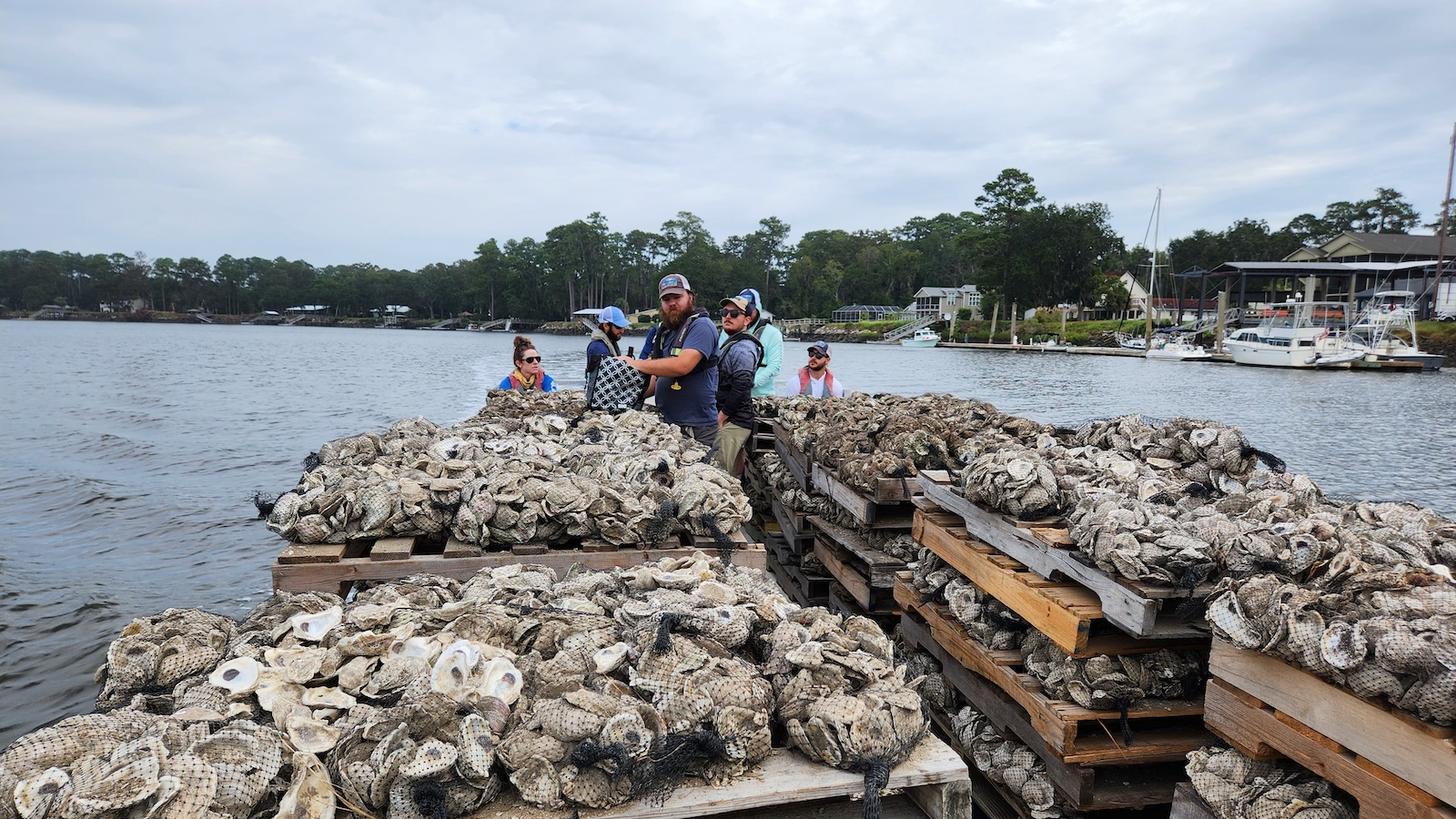
This coverage is made possible through a partnership with WABE and Grist, a nonprofit, independent media organization dedicated to telling stories of climate solutions and a just future.
On a sunny day this fall, two Georgia Southern University grad students stood waist-deep in the North Newport River near St. Catherine’s Island on Georgia’s coast, while their professor and a team from the Georgia Department of Natural Resources used a winch to lower pallets full of oyster shells into the water.
The students guided the pallets into place on the muddy river bank. Those pallets, piled with shells, will provide a hard surface for baby oysters to latch onto.
“We are creating a foundation which wild oysters can populate and grow into a independent reef,” said Cameron Brinton, a marine biologist with DNR.
Oysters used to be abundant here: Georgia led the nation in oyster harvesting in the early 20th century, according to the University of Georgia. But by the 1930s, they’d been overharvested. A similar story has played out in other formerly thriving oyster grounds.
Scientists all along the Atlantic and Gulf coasts are trying to bring oyster populations back, and not just because they’re a popular food. Oysters are also important for healthy coastal ecosystems. And researchers are now studying how creating new oyster reefs could help fight climate change by sequestering carbon.
Oysters, Brinton explained, are a keystone species. That means they create habitat for other critters, from small shrimp and crabs to fish like red drum and spotted sea trout that are popular for fishing.
“The majority of commercially and recreationally important species of fish and shellfish will spend a portion of their life associated with oyster reefs,” Brinton said.
And scientists are studying two ways that oyster reefs suck up and store carbon. First, they keep the sediment in the river from washing away.
“There’s lots of organic matter in this sediment in the rivers here,” said John Carroll, a professor of biology at Georgia Southern. “So some of that organic matter gets buried behind the reefs.”
Organic matter has carbon in it, so the oyster reefs can store that carbon and keep it from warming the planet.
Second, by stabilizing the shoreline, oyster reefs also help marshes expand — and marshes themselves are very good at storing carbon.
“As the marsh grasses grow toward the reefs, they’ll also trap a lot of carbon,” Carroll said.

Grist / Emily Jones
So Carroll and his students are helping the Georgia DNR build these reefs. Then, they’ll track how the shoreline changes and how much carbon it’s storing.
The project is funded by the environmental arm of Yamaha, the boat engine maker. The company, with manufacturing headquarters for the United States located in the Atlanta area, is looking for ways to offset its carbon impact, and a project on Georgia’s coast made sense, said sustainability program manager Josh Grier.
“It’s something that our customers who are out using our products can see,” he said. “Not only are we investigating how we could potentially sequester CO2, but also providing habitat for fish, you know, kind of giving back into the communities where our customers are using our products.”
Marine combustion — that is, ship and boat engines — produced 23.7 million metric tons, or MMT, of CO2 equivalent emissions in 2020, according to the Environmental Protection Agency. That accounts for a tiny fraction of overall transportation emissions, which were more than 1,500 MMT CO2-equivalent in 2020, mostly from roads.
Yamaha is funding similar research into oyster reefs and carbon sequestration in the Gulf of Mexico through Texas A&M University. The two projects could make for an interesting comparison, Grier said, because the Atlantic coast of Georgia and the Gulf coast of Texas differ a lot in their tides, salinity, and other factors that can influence oyster growth.
“They’re such different environments that we’re very curious to see kind of how the CO2 sequestration manifests itself over time,” Grier said.
Once researchers are able to quantify the carbon storage, Carroll said, he’s hopeful Yamaha and other companies will want to fund more oyster reefs.
“There’s lots of need,” he said. “It just boils down to having enough of the materials.”
This story was originally published by Grist with the headline How much carbon can oysters store? Scientists are trying to find out. on Dec 7, 2023.
